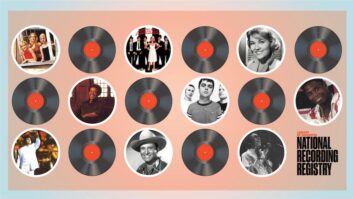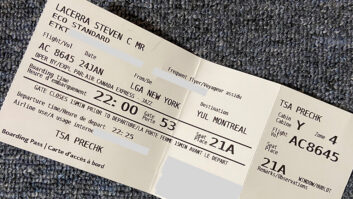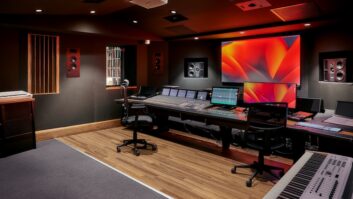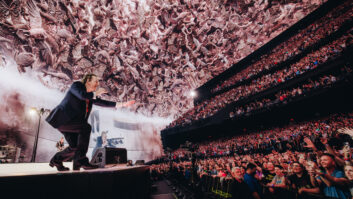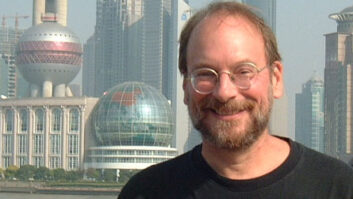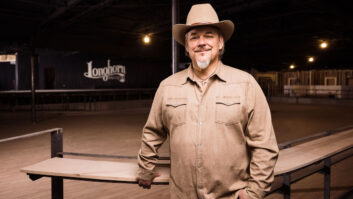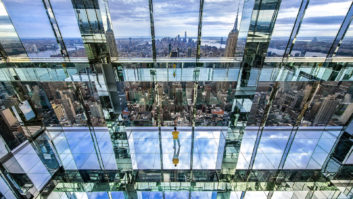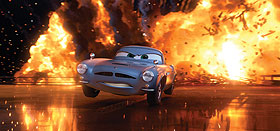


Rather than just being a formulaic re-tread (sorry) of the mega-successful 2006 Cars, Disney/Pixar’s Cars 2 ups the ante by being much more than a racing movie.
“It’s an action and adventure, a spy movie, it’s a comedy and it’s racing all folded into one, so it’s much more intricate than the first one,” comments Michael Silvers, the film’s co-supervising sound editor, along with Tom Myers (also lead sound designer and FX re-recording mixer). Myers adds, “The opening is completely disconnected from what your expectation is. You start with this set piece that’s like something out of a Bond movie or the Bourne films.” That opening segment, which takes place out on the ocean, at night, is one of several exotic locales that required imaginative thinking from the sound crew; there are also race scenes in Japan, Italy, France and England, and a chase through a market in France. Another wrinkle: Cars 2 joins Toy Story 3—also supervised by Myers and Silvers, with Michael Semanick mixing music and dialog—as the second animated feature from Pixar to be mixed in the Dolby 7.1 Surround format (as well as conventional 5.1 theatrical and home surround).
“We were much more aggressive with the 7.1 this time and were really encouraged to use it by [director] John Lasseter, who’s a big surround fan,” Myers comments of the format, which adds two additional rear speakers to a standard 5.1 setup. “We were cautious not to put any super-important dialog or anything we didn’t want to lose as a story point solely back there. But in terms of effects, we tried to go whole-hog and use it as much as possible and create as much space, and also use discrete side and back stuff.
“There’s a scene in a casino where we wanted to create this active space,” he continues, “so there are all these different sound effects back there and we moved a lot of things around. In the races, as well: There are all sorts of interesting car-bys—we designed it so we have things flying by, coming out of the surrounds onto the screen to off the screen into the surrounds.”
Myers says that because Cars 2 is also being released in 3-D, this affected his and Semanick’s surround mixing decisions, and that the 7.1 provided more sonic real estate with which to work. “Because of where they were with picture, the 3-D was not completed until fairly late,” he notes. “Originally, we wondered if we would want to do a separate mix [for the 3-D prints], but we decided that we did enough aggressive surround stuff to begin with and we were conscious of trying to anticipate it—‘Oh, that’s going to be a big 3-D effect so let’s pull that off the screen into the surrounds.’”
Did the 7.1 mix pose any technical challenges? “It was more on the creative level,” Myers says. “It’s two more speakers, another region to work with, but you also have to think about how you get there. Sometimes, console panning is not as facile as it could be, so you have to think, ‘I want it to go from here to here. How do I make it do that?’ You can often sort of ride it through, but sometimes splitting it between the front and the back is difficult, or you have to set up another aux send to do that.” The film was posted at Skywalker Sound in Marin County, Calif., and mixed on a Neve DFC.

Michael Silvers, the film’s co-supervising sound editor

Tom Myers

Michael Semanick mixed music and dialog
“We did the 7.1 mix first,” Myers notes, “then a fold-down pass from our 7.1 stems and made 6.1 discrete stems and the 5.1 EX print master from that. A lot of that involved Michael [Semanick] trying to figure out how to do the music—putting a delay into the surrounds because you’re folding four surround channels into two and you want to avoid phasing. Most of my surround information was fairly discrete. I had some ambient stuff in the sides and the back, but mostly it was discrete information so I didn’t have to worry as much about phasing.”
Silvers, who specializes in dialog and ADR issues, found himself having to, in effect, follow the characters around the world, amassing crowd and other material in Japanese, French and Italian to make the film’s foreign settings come alive. Contracting with ADR studios in those countries (and in England), “We got French walla, Japanese walla, we got Italian walla, we got English walla,” Silvers says. “I’d ask the loop group, ‘What would be typical chanting at a sporting event in that country?’ And then they’d send it to me. We have announcements and scenes in restaurants and various wallas in these locales. They had to send me translations of everything, and they were very good about that.”
On the FX side, a plethora of new cars demanded “a ton of new recording,” Myers says, including a slew of Formula 1 race cars, a fabulous $200,000 Aston Martin V12 Vantage (which Myers got to drive around Skywalker Ranch to capture some engine sounds) and even some funky old Gremlins and Pacers. “Because there are so many different cars in this one,” Myers says, “the race sequences are more elaborate, so it was important to make the cars more unique-sounding, to have their own personalities.”
The sound designer/editors also liberally employed library engine FX they’ve accumulated over various projects, particularly handy for recurring lead characters Lightning McQueen and Mater, the dilapidated redneck tow truck. “We have a big library of Mater sounds,” says Myers, who also works on the Cars shorts. “John sees Mater as kind of like Goofy: You can put him in any situation and he’ll be funny, whether he’s a private eye or an astronaut.”
Lasseter has always been a sound-conscious director, but he was even more involved with the final mix. “I’ve worked on 10 Pixar films and this was the only time he’s ever been in the mix the whole time, though he’s certainly always paid attention before,” says Silvers. “We final mixed for about four weeks, screened it and then refined the mix for seven days. We made some major leaps.”
Lasseter would often sit at the console between Myers and Semanick as they worked out the balance of music, FX and dialog, an untold number of Pro Tools sessions at their disposal. There were new FX and vocalizations that came in during the final and, as Silvers mentions, the subtractive process was as important: “In all the races, Brent Musburger [“Brent Mustangburger” in the film] is doing the announcing, and we actually dropped lines in certain places because we realized we were losing some of the energy of the race. We also dropped score, and in other instances we dropped car effects in favor of score. We wanted to make sure we weren’t overwhelming people with too many things.”
“One of the things we learned starting with the first Cars,” Myers adds, “is that we want it to be more quality over quantity in terms of not trying to cover every last thing before we get to the stage, because then you spend half your mix trying to weed it all out. We talked to John early on, and said, ‘We’re going to try to cut the stuff we absolutely think we need, and then if there’s something you want that you don’t hear, we’ll cut it there.’ He’s a very smart filmmaker. I was reminded what a great grasp he has of the tools we’re using. He knew that there are certain things—like crowd and ambient wind and dirt or whatever; white noise-y, shush-y effects—that he might want, but once you put the music in, it’s taking up frequency range. So with each progressive film, we’ve tried to be more precise about what it is that we’re doing with the sound—in other words, trying to be selective and pick things more precisely.”
Blair Jackson is
Mix
’s senior editor.

AVID, DOLBY, 7.1
It’s hard to predict right now just how the 7.1 rollout will take place on the playback side, either in the home or in theaters. Yes, it is part of the Blu-ray spec, and, yes, there are thousands of theaters equipped for it today. High-profile 3-D films are embracing the technology, and studios no doubt see dollar signs with the re-release of catalog material. But will consumers put in additional speakers and buy new hardware? Will they adapt and adopt to the new format as quickly and assuredly as they did 5.1 playback in the ’90s?
Dolby is betting they will, having shown a slew of new playback options at the recent NAB show, everything from mobile phones to optimized PC chip sets to consumer A/V devices and headphones. And, of course ,theatrical playback. DTS is also pushing the technology, having done very well in the still-early stages of Blu-ray authoring/encoding and with the limited titles in theatrical release. There will no doubt be many more options—from other manufacturers, too—and the broadcast industry will have to chime in eventually, as will the videogame industry.
Every new format introduction presents its own “chicken-egg” scenario: It’s hard to sell the systems if there isn’t content, and studios are loath to invest in the content without some indication that there will be a payback. But that sorts itself out in the marketplace and doesn’t really matter to the creatives, the sound editors and re-recording mixers who must deliver the 7.1 track. They just want the tools that allow them to push a more immersive audio experience.
It’s not surprising then that Avid and Dolby have informally partnered up on delivering the tools for creating and delivering 7.1 audio. Pro Tools is the dominant format in Hollywood, and Dolby maintains market share in encode/decode. In April, they announced Dolby Surround Tools for TDM systems, a new plug-in for 7.1 panning in Pro Tools 9 (pictured).
“As more and more of our customers have transitioned to mixing ‘in the box,’ the need for 7.1 panning support in Pro Tools has continued to grow,” says Max Gutnik, senior director of product management at Avid. “We began to implement 7.1 solutions into our workflows with Pro Tools|HD 9 and Complete Production Toolkit 2. At the same time, we updated the monitor section of our HD OMNI interface to include 7.1, and extended that support even further by updating several of our plug-ins to be compatible with the new format.”
Look for a lot more action in the 7.1 space, definitely from the creative side.
—Tom Kenny
